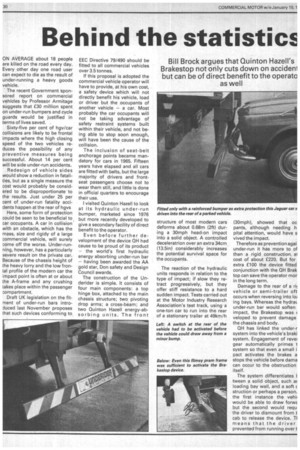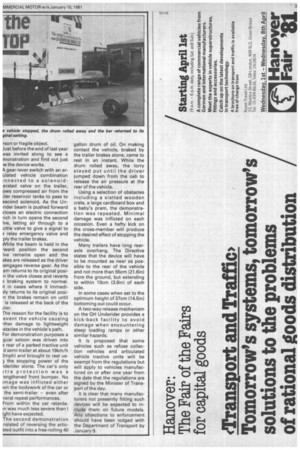Behind the statistics
Page 32

Page 33

If you've noticed an error in this article please click here to report it so we can fix it.
Bill Brock argues that Quinton Hazell's Brakestop not only cuts down on accideni but can be of direct benefit to the operato as well
ON AVERAGE about 18 people are killed on the road every day. Every other day one road user can expect to die as the result of under-running a heavy goods vehicle.
• The recent Government sponsored report on commercial vehicles by Professor Armitage suggests that £30 million spent on under-run bumpers and cycle guards would be justified in terms of lives saved.
Sixty-five per cent of hgv/car collisions are likely to be frontal impacts where the high closing speed of the two vehicles reduces the possibility of any preventive measures being successful. About 14 per cent will be side under-run accidents.
Redesign of vehicle sides would show a reduction in fatalities, but as a single measure the cost would probably be considered to be disproportionate to the results. Just under 25 per cent of under-run fatality accidents happen at the rear of hgvs Here, some form of protection could be seen to be beneficial to car occupants. A car in collision with an obstacle, which has the mass, size and rigidy of a large commercial vehicle, will surely come off the worse. Under-running, however, has a particularly severe result on the private car. Because of the chassis height of the heavy lorry and the low frontal profile of the modern car the impact point is often at or about the A-frame and any crushing takes place within the passenger compartment.
Draft UK legislation on the fit'nent of under-run bars introduced last November proposes that such devices conforming to EEC Directive 79/490 should be fitted to all commercial vehicles over 3.5 tonnes.
If this proposal is adopted the commercial vehicle operator will have to provide, at his own cost, a safety device which will not directly benefit his vehicle, load or driver but the occupants of another vehicle — a car. Most probably the car occupants will not be taking advantage of safety restraint systems built within their vehicle, and not being able to stop soon enough, will have been the cause of the collision.
The inclusion of seat-belt anchorage points became mandatory for cars in 1965. Fifteen years have elapsed and all cars are fitted with belts, but the large majority of drivers and frontseat passengers choose not to wear them still, and little is done in official quarters to encourage their use.
I visited Quinton Hazell to look at its hydraulic under-run bumper, marketed since 1976 but more recently developed to give a secondary facility of direct benefit to the operator.
Even before further development of the device QH had cause to be proud of its product the world's first hydraulic energy absorbing under-run bar — having been awarded the AA gold star, Don safety and Design Council awards.
The construction of the Underider is simple. It consists of four main components: a top hinge box, attached to the main chassis structure; two pivoting drop arms; a cross-beam; and two Quinton Hazell energy-absorbing units. The front structure of most modern cars deforms about 0.68m (2ft) during a 30mph head-on impact into a solid object. A controlled deceleratrion over an extra 34cm (13.5in) considerably increases the potential survival space for the occupants.
The reaction of the hydraulic units responds in relation to the type of impact; if slow they retract progressively, but they offer stiff resistance to a hard sudden impact. Tests carried out at the Motor Industry Research Association's test track, using a one-ton car to run into the rear of a stationary trailer at 49km/h (30mph), showed that oc pants, although needing h pital attention, would have s vived the impact.
Therefore as prevention agai under-run it has more to of than a rigid construction, al cost of about £220. But for extra £100 the device fitted conjunction with the QH Brak top can save the operator mor in the long term.
Damage to the rear of a rii vehicle or semi-trailer oft occurs when reversing into Im ing bays. Whereas the hydrai under-run bar would soften impact, the Brakestop was c veloped to prevent damage the chassis and body.
QH has linked the under-r system into the vehicle's braki system. Engagement of revel gear automatically primes t system so that even a small i pact activates the brakes a stops the vehicle before dama can occur to the obstruction itself.
The system differentiates I tween a solid object, such at loading bay wall, and a soft c struction or perhaps a person. the first instance the vehil would be able to draw forwz but the second would requ the driver to dismount from t cab to release the device. TI means that the driver prevented from running over t rson or fragile object.
Just before the end of last year /vas invited along to see a monstration and find out just w the device works.
gear-lever switch with an arulated vehicle combination ,nnected to a solenoiderated valve on the trailer, ows compressed air from the iler reservoir tanks to pass to second solenoid. As the Unrider beam is pushed forward closes an electric connection lich in turn opens the second lye, letting air through to a uttle valve to give a signal to a relay emergency valve and ply the trailer brakes.
VI/hile the beam is held in the -ward position the second lye remains open and the akes are released as the driver
• ;engages reverse gear. As the am returns to its original posin the valve closes and reverts 3 braking system to normal. it in cases where it immedialy returns to its original posiIn the brakes remain on until
• is released at the back of the
The reason for the facility is to event the vehicle causing -ther damage to lightweight 'stades in the vehicle's path. For demonstration purposes a guar saloon was driven into rear of a parked tractive unit d semi-trailer at about 19km/h ?mph) and brought to rest usthe stopping power of the Iderider alone. The car's only ctra protection was a -engthened front bumper. No image was inflicted either ion the bodywork of the car or the semi-trailer — even after veral repeat performances. From within the car retardain was much less severe than I ight have expected.
The second demonstration nsisted of reversing the articated outfit into a free-rolling 40 gallon drum of oil. On making contact the vehicle, braked by the trailer brakes alone, came to rest in an instant. While the drum rolled away, the lorry stayed put until the driver jumped down from the cab to release the air pressure at the rear of the vehicle.
Using a selection of obstacles including a slatted wooden crate, a large cardboard box and a baby's pram, the demonstration was repeated. Minimal damage was inflicted on each occasion. Even a hefty kick on the cross-member will produce the desired effect of stopping the vehicle.
Many trailers have long rearaxle overhang. The Directive states that the device will have to be mounted as near as possible to the rear of the vehicle and not more than 55cm (21.6in} from the ground, but extending to within 10cm (3.9in) of each side.
In some cases when set to the optimum height of 37cm (14.5in) bottoming out could occur.
A two-way release mechanism on the QH Underider provides a kick-back facility to avoid damage when encountering steep loading ramps or other similar hazards.
It is proposed that some vehicles such as refuse collection vehicles and articulated vehicle tractive units will be exempt from the regulations but will apply to vehicles manufactured on or after one year from the date that the regulations are signed by the Minister of Transport of the day.
It is clear that many manufacturers not presently fitting such devices will be expected to include them on future models. Any objections to enforcement should have been lodged with the Department of Transport by January 9.




























































































